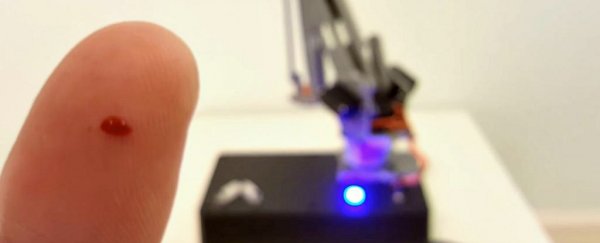A roboticist from California has just unveiled a machine that purposefully stabs people with a needle, making it the first ever robot that's been created with the sole intention of doing harm to humans.
In the hopes of sparking an ethical debate, the creation goes directly against biochemist Isaac Asimov's first and second laws of robotics, which state, in summary: "Robots may not harm people," and "A robot must obey orders given it by human beings except where such orders would conflict with the First Law."
The machine's creator, roboticist and artist Alexander Reben from Stochastic Labs in Berkeley, California, decided to make the nightmarish creation after noticing that many people around the world share a fear of robots, Daniel Terdiman reports for Fast Company.
Though he isn't exactly sure where this fear comes from, Reben says it might stem from the fact that machines have the capacity to impose physical danger on humans if things go wrong, plus we keep hearing about robots taking over our jobs, and maybe even the planet.
So, to force some lucky volunteers to confront these fears, Reben has – for better or worse – invented the world's first pain-inducing robot.
"No one's actually made a robot that was built to intentionally hurt and injure someone," Reben told Fast Company. "I wanted to make a robot that does this that actually exists …That was important, to take it out of the thought experiment realm into reality, because once something exists in the world, you have to confront it. It becomes more urgent. You can't just pontificate about it."
The robot itself is a rather unintimidating black box with a mechanical arm fixed to the top of it. A user – if that's even the right word – places their finger inside a pair of brackets, which alerts the robot of its presence.
In a flash, the robot swings over and jabs the crap out of the person's finger, causing them to bleed.
 Alexander Reben
Alexander Reben
As mentioned above, the robot is designed to go against the Three Laws of Robotics that Isaac Asimov spelt out in his 1942 short story, Runaround.
- A robot may not injure a human being or, through inaction, allow a human being to come to harm.
- A robot must obey the orders given it by human beings except where such orders would conflict with the First Law.
- A robot must protect its own existence as long as such protection does not conflict with the First or Second Laws.
These three laws have long been pondered by philosophers and other ethicists who aim to understand how humanity might cope with their increasingly powerful and inevitable robot population, but this is the first time that someone has set out to break them on purpose, to force people to truly think about this in the physical sense.
"I want people to start confronting the physicality of it. It will raise a bit more awareness outside the philosophical realm," Reben told Fast Company. "There's always going to be situations where the unforeseen is going to happen, and how to deal with that is going to be an important thing to think about."
While Reben has taken the violent route, other scientists around the world are trying to make robots gentler and more empathetic. For example, earlier this year, researchers from Germany began building robots that can sense pain themselves, which should safeguard the people they work with.
It's not yet clear how Reben's robot will influence the ethical discussions scientists are having about robots, but it's safe to say that it's going to spark some sort of conversation, which is exactly the point.
Check out the robot in action below. (Warning: it's a bit gross.)
